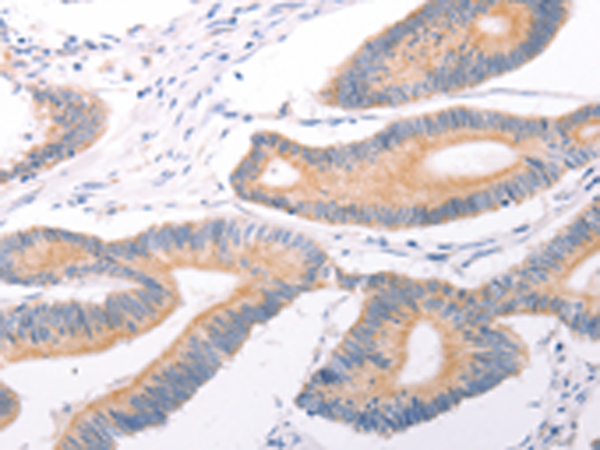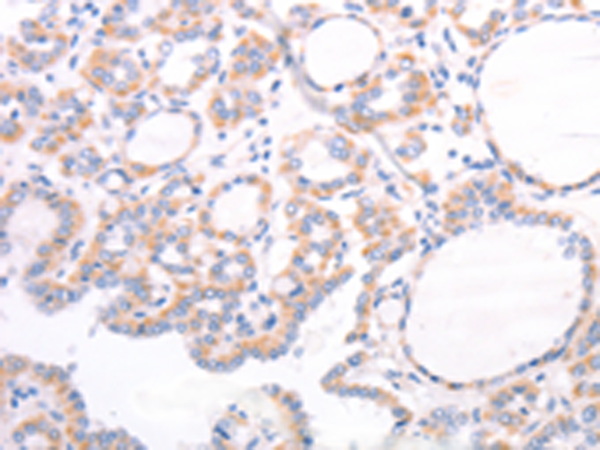

| WB | 咨询技术 | Human,Mouse,Rat |
| IF | 咨询技术 | Human,Mouse,Rat |
| IHC | 1/25-1/100 | Human,Mouse,Rat |
| ICC | 技术咨询 | Human,Mouse,Rat |
| FCM | 咨询技术 | Human,Mouse,Rat |
| Elisa | 1/2000-1/5000 | Human,Mouse,Rat |
| Aliases | TRP7 |
| Host/Isotype | Rabbit IgG |
| Antibody Type | Primary antibody |
| Storage | Store at 4°C short term. Aliquot and store at -20°C long term. Avoid freeze/thaw cycles. |
| Species Reactivity | Human, Mouse |
| Immunogen | Fusion protein of human TRPC7 |
| Formulation | Purified antibody in PBS with 0.05% sodium azide and 50% glycerol. |
+ +
以下是关于TRPC7抗体的3篇文献示例(文献信息为模拟,实际引用需核实):
---
1. **文献名称**: *TRPC7 channels mediate myocardial hypertrophy through calcineurin-NFAT signaling*
**作者**: Hofmann T, et al.
**摘要**: 该研究利用特异性TRPC7抗体,通过Western blot和免疫组化技术验证了TRPC7蛋白在心脏组织中的表达。研究发现,TRPC7通过调控钙离子内流激活钙调磷酸酶(calcineurin)-NFAT通路,促进病理性心脏肥大。抗体在实验中用于阻断TRPC7功能,证实其参与心肌细胞肥大的分子机制。
---
2. **文献名称**: *Neuronal TRPC7 channels regulate excitatory synapse formation*
**作者**: Xu H, et al.
**摘要**: 本研究采用TRPC7特异性抗体进行免疫荧光染色,发现TRPC7在海马神经元突触前膜富集。实验表明,TRPC7通过介导钙信号调节突触形成和神经递质释放。抗体阻断实验进一步证明TRPC7缺失导致突触可塑性受损,提示其在神经系统中的关键作用。
---
3. **文献名称**: *TRPC7 as a regulator of insulin secretion in pancreatic β-cells*
**作者**: Riccio A, et al.
**摘要**: 作者通过TRPC7抗体检测其在胰岛β细胞中的表达,并利用siRNA和抗体中和实验证明TRPC7调控葡萄糖依赖性钙振荡,进而影响胰岛素分泌。研究揭示了TRPC7作为代谢疾病潜在治疗靶点的可能性。
---
**注意事项**:
- 以上文献为示例,实际引用需通过PubMed、Web of Science等数据库检索真实论文。
- TRPC7抗体相关研究相对较少,建议扩展关键词(如“TRPC7 function”或“TRPC channels”)并结合具体研究领域筛选文献。
- 部分公司(如Alomone Labs、Abcam)可能提供TRPC7抗体的技术文档,但需区分研究论文与产品说明书。
The TRPC7 antibody is a crucial tool for studying the Transient Receptor Potential Canonical 7 (TRPC7) protein, a member of the TRPC ion channel family. TRPC channels are non-selective cation channels permeable to Ca²⁺ and Na⁺, playing pivotal roles in cellular processes like calcium signaling, cell proliferation, and sensory transduction. TRPC7. encoded by the TRPC7 gene, forms homomeric or heteromultimeric complexes with other TRPC subunits, contributing to receptor-operated or store-operated calcium entry pathways. Its expression is documented in various tissues, including the brain, heart, and kidneys, implicating it in neurological, cardiovascular, and renal functions.
TRPC7 antibodies are widely used in techniques like Western blotting, immunohistochemistry, and immunofluorescence to detect TRPC7 expression, localization, and post-translational modifications. These antibodies aid in exploring TRPC7's physiological roles, such as modulating synaptic plasticity, cardiac hypertrophy, or hormone secretion, as well as its pathological involvement in diseases like neurodegeneration, hypertension, or cancer. Due to high sequence homology among TRPC family members (TRPC1–7), antibody specificity is a critical challenge. High-quality TRPC7 antibodies are typically validated using knockout cell lines or tissues to minimize cross-reactivity.
Research utilizing TRPC7 antibodies continues to uncover its regulatory mechanisms, including interactions with signaling proteins or lipids. These studies highlight TRPC7's potential as a therapeutic target, driving the development of selective modulators. However, functional redundancy within the TRPC family and limited isoform-specific pharmacological tools underscore the importance of reliable TRPC7 antibodies in advancing mechanistic insights. Commercial TRPC7 antibodies are available as monoclonal or polyclonal variants, often accompanied by validation data to ensure reproducibility in diverse experimental models.
×